It is not many years since the outer lane of Britain’s motorways underwent a change, with the latest Fords and Vauxhalls that used to dominate this roadspace replaced, so it seemed, by too many aggressively driven Audi A4s, almost all of which, on closer inspection turned out to be the TDi S-Line models. Seemingly overnight, Audi’s mid-sized saloon went from being a “cut above the average” to being a common car, and one cursed by the poor standards of driving from many of its users. Although the British press were never more than moderately enthusiastic about the A4, preferring the rear wheel drive German rivals, sales volumes rocketed and it seemed the car could do no wrong. But then, the company car taxation system changed, and as so many of these vehicles were indeed fleet cars, when it became clear just how much more efficient the BMW Efficient Dynamics technology and thus what significant savings could be derived by driving the Munich WunderKind instead, the Audi appeared to lose some sales momentum.
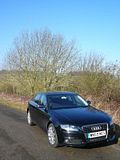
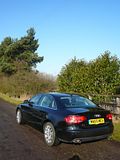
It did not help that many of its buyers have been convinced of the perceived superiority of rear wheel drive (though the recent snow and ice proved that whether this statement is true or not, there are times when it is a positive liability!), leaving Audi with something of a challenge.
The B8 model of the A4, launched at the Frankfurt 2007 show was Ingolstadt’s hope that they could change all this, and fight back not just against the BMW, but also the really rather competent C Class Mercedes and any other potential competitors for their vitally important volume seller. It would be fair to say that whilst in Germany, where the press tend to favour Audi just as blindly as the Brits favour the BMW, the new car was extremely well received and there have been months where it has been the second biggest selling car in the German market, in the UK the launch reaction was more muted, and sales, whilst steady, have not been stunning. I sampled a fairly early version of the B8 model on vacation in Portugal in August 2008, but it is only now that I have had the chance to test one in the UK, where I could also get the opportunity to see what smaller alterations had been made since launch.

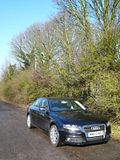
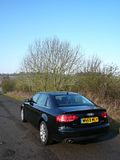
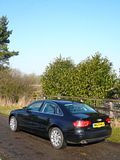
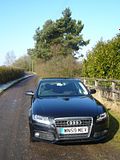
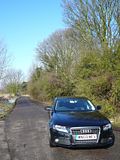
There are a bewildering array of models available in the A4 range, just as used to be the case when Ford and Vauxhall ruled the Company Car Roost and they needed to have lots of subtle differences in engine and trim, along with an options list longer than your arm. My test car was probably one of the best selling models in the range, combining the latest 2.0 TDi engine, in 143 bhp form, with the SE level trim. Priced approximately £1000 above the standard trim and £2000 below the S-Line trim, many will decide that this brings an appropriate set of features without the ride-challenging harsher suspension and larger 18″ alloys of the S-Line. The options list is extensive, though, just as you would expect, so you can easily personalise your A4 to the tune of your budget.




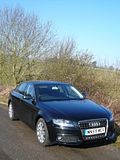
Last year I sampled the latest VAG Group 2.0 TDI engine in a Golf was impressed by the massive step forward in refinement that I found. I am pleased to report that the engine is equally good when installed in the Audi. Only just audibly a diesel on start up, the engine idles smoothly and so much more quietly than its rather gruff Pumpe Duese predecessors, and once underway is as civilised as many a petrol engine. You know it is not a petrol engine as this one has far more torque than todays emissions-optimised high geared petrol motors tend to be, so it has good pulling power from fairly low down the rev range all the way to the 4500 rpm red line. The engine is smooth, and it does the job that is asked of it very well. Not only that, but it is impressively economical. In my test, which amounted to a mainly mortorway trip to west London, with a lot of time spent in traffic jams, I averaged 57 mpg, which is one of the best figures I have seen from any car for a long while, let alone for a 2.0 five seater saloon. The good news does not stop there. The gearbox also has to rank as one of the sweetest changing ‘boxes of a VAG I’ve ever encountered. Gone is the awkward notchiness that always used to be at least slightly evident, as in this car, the lever slotted from ratio to ratio with all the precision and smoothness of the proverbial knife through butter. Even the selection of reverse, forwards and to the left of first was cleanly engaging every time, with the result that it was no hardship to use the gears a lot, and as you will read, at least as an experiment, I did.
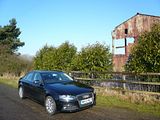
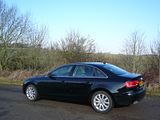


When the B8 version of the Audi A4 was launched, much was made of the fact that the engine and gearbox were mounted further back in the car and the press gushed enthusiastically how this would transform the handling characteristics that they were always so quick to castigate. For a start, on every day roads, as opposed to a track, I never really found the problem to be anything like as bad as they would have had us all believe, and secondly the more rearward placement amounted to a massive 154mm (or 6″), which in the scheme of things is small enough to be unlikely to make a huge difference. Did I have a problem with the handling of the test car? Er, no. Did I find the steering “inert”, as the British press moan? Er, no again. Did the test car ride badly? No, but this was an SE and not the S-Line, so maybe the smaller wheels (17″) and less stiff suspension would just help out there, as I would admit that compliancy of the ride is not an Audi feature! The brakes were good, with the exception of the cursed finger-tip operated electronic parking brake, which simply did not always engage when you set it, needing a second go, and was also sometimes reluctant to disengage. I still struggle to see why these wretched things are any real benefit. Visibility is good, with ample assistance provided by the mirrors, so judging the extremities of the A4 is as easy as you are likely to find a medium-market saloon these days.
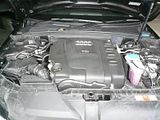
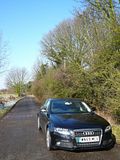

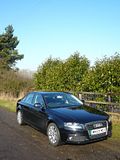
As part of the quest to reduce CO2 emissions – vital not just because it is a Good Thing to do, but when so many of your sales in a key market such as the UK are to fleet customers where Benefit in Kind taxation is set based on the emissions rating – a couple of new features were evident on this A4. There is a Stop-Start system, and an little indicator which tells when you should change up a gear. Dealing with the second of these first, I have to say that although it was interesting to see what it thought were the optimum change up points, I found myself disagreeing and ignoring it most of the time. No matter how you were driving, the indicator would suggest that once you reached about 1600rpm, you should change up. If you were above about 2100 rpm it would likely suggest very discretely that you went up two ratios. Despite the strong torque of the engine, at that speed, frankly there is just no acceleration at all and following the advice could even be dangerous. So, a helpful indicator, perhaps, but no more than a a suggestion, I would submit. l had a reservation about Stop-Start, too. Come to a stand-still, put the car in neutral and take your foot off the clutch and the engine cuts out. As soon as you put your foot on the clutch, it restarts. Very clever, but I have to say that it takes longer to fire the motor than it does to move the gearlever into first, so if you are sitting at lights, unless you anticipate slightly the ability to move away, you will be have to pause just slightly longer than you otherwise would have done.
I also spent a frustratingly large part of the return journey to Bristol queued up in a number of separate motorway jams. The issue here is that the traffic was stationary for random periods of time. Often not very long, so the engine was stopping and almost immediately being asked to start again. I just hope that all the durability testing is such that the extra strain that I was clearly putting on the starter motor would not massively shorten its life. That said, we are all likely to be faced with these systems before long, so we had better to get used to them!

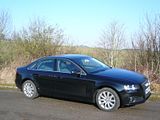

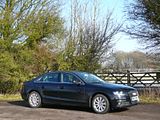
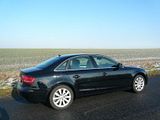
When the right hand drive models of the latest A4 were first tested by the Press, there was a huge and justified complaint about the driving position. Somehow, it had all gone wrong, and the position was awkward, offset too far to the right, which made the car simply too uncomfortable for many. I recall that several of my colleagues, enthused at the idea of the A4, all ended up selecting an alternative marque as a consequence. Either Audi have addressed the problem, or I simply did not notice it, but whereas it was obvious to me when I sampled the S5 (largely the same seating position) and even in the left hand drive Portuguese rental car you did not feel to be sitting straight, in this car, I noted nothing unusual. As with almost all my recent test cars, although there was adjustment in/out and up/down of the steering wheel, by the time I had set the seat correctly for the pedals, I felt I would have like to move the steering wheel in a bit more and up a bit more, but I quickly adjusted to this slight compromise. The seat itself, covered in what Audi call Cosinus (a not particularly nice – though I have encountered worse- sort of hard-wearing synthetic cloth something) did prove comfortable, though. Once installed in the A4, you gaze at a dashboard that could only be an Audi. The design, shared with the A5/S5 models is very similar to that which you find in the A6/S6 models, and amounts to a rather more sizeable moulding than you used to get in the old B7 model A4 cars.
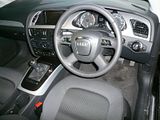
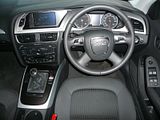
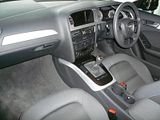
The steering wheel is leather covered and is just as nice to hold as the one in my S6. There are brushed aluminium inlays on the dash and the doors, which have a slight weave pattern to them, but to my mind are probably more appropriate for this car than the carbon fibre weave you get in the S-Line models. The quality is absolutely superlative, though, both in terms of fit, finish and design. Truly, Audi are masters at this aspect of their vehicles. The main dials are directly in front of the driver and comprise a speedo and rev counter. Between them is a digital display area which includes not just the odometer and the gear change-up indicator, but a small display area for trip computer functions and the top part allows you to show one feature (I set it to a digital display of the speedo, as I have it on my S6). Fuel and water temperature gauges are in the lower half of the larger dials. In the centre of the dash is a display screen for the radio setting and also more vehicle info displays and, if fitted, the sat nav (it was not on my car). The radio system itself is underneath this and is controlled by traditional knobs and buttons and is pretty easy to use. Beneath this is the 3 zone climate control system, with separate controls for driver and passenger, which again is easy to use even for those who are not habitual Audi drivers. There is a light switch to the right of the column, with auto sensing lights and there are stalks on each side of the column for indicators and wipers, also with auto sensing wipers. All the controls are pleasant to the touch and they operate in a way that gives you the impression they are tough and could go for ever. Between the seats there is less to find when you have no Sat Nav and hence no MMI control, but there is the handbrake button to the right of the gearlever. The rest of the space is given over to mouldings for cup holders and oddments space.
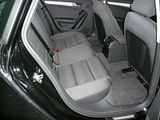
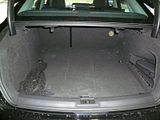
Successive generations of the A4 have grown that little bit each time, and whereas the B6/7 models were a little tight in the rear, there is now ample space for adults to sit comfortably in the back seats, where they will find plenty of legroom and headroom,. The boot has grown in capacity too, and is deep from back to front. There is a lipped shelf on the offside, where Audi had located the spare bottle of oil, and there was a luggage net in the boot, though it was not actually attached to any of the securing points that are on the boot floor. Under the floor you will find a space saver spare wheel. The rear seat backrests can be folded forward to provide extra luggage space, if required. Inside the cabin, the usual door pockets, glove box and oddment space between the seats are adequate but not notably generous.
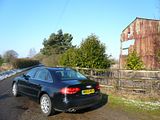
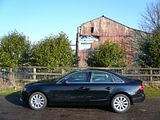
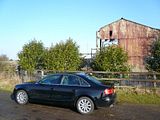
As I was crawling west along various part of the M4, still intent on handing the A4 back to the garage, as agreed before they closed the Service Department for the weekend, I reflected on the merits of the A4 TDi. With the exception of the odious electronic handbrake, for me there are no weak points on this car. The latest engine has transformed the TDi from being something you would consider for fiscal reasons to being a powerplant you could actively choose. When I looked up the list price of the model I had been driving, I was pleasantly surprised to find that it is under £26,000. Considering that cars from the class below, with rather less room in them like the Focus and the latest Astra are well over £21,000 in their 2.0 diesel incarnations, and that those diesel engines are still a bit on the agricultural side of things, the A4 is even reasonable value for money, especially when you consider how much more of its value it would retain than a Focus or Golf. As I completed these musings, I arrived back at Bristol Audi to see my much loved S6, washed and cleaned inside, and looking almost like new despite its 40,000 miles. Of course I would rather drive that car every day, but it is expensive just to fuel and the tax is, well, let’s not go there. As an alternative for less than half the purchase price, you are getting a lot of the Audi Goodness with the A4 TDi 143, and if circumstances forced me to have cut back to those levels, well, I dare say I would cope. Quite happily, if I am honest, as the latest A4 is a genuinely good car.
2010-02-26 20:16:05






































